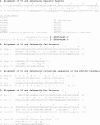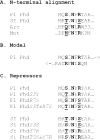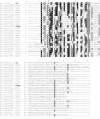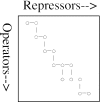Percolation of the phd repressor-operator interface
- PMID: 15743936
- PMCID: PMC1064050
- DOI: 10.1128/JB.187.6.1901-1912.2005
Percolation of the phd repressor-operator interface
Erratum in
- J Bacteriol. 2005 May;187(9):3287
Abstract
Transcription of the P1 plasmid addiction operon, a prototypical toxin-antitoxin system, is negatively autoregulated by the products of the operon. The Phd repressor-antitoxin protein binds to 8-bp palindromic Phd-binding sites in the promoter region and thereby represses transcription. The toxin, Doc, mediates cooperative interactions between adjacent Phd-binding sites and thereby enhances repression. Here, we describe a homologous operon from Salmonella enterica serovar Typhimurium which has the same pattern of regulation but an altered repressor-operator specificity. This difference in specificity maps to the seventh amino acid of the repressor and to the symmetric first and eighth positions of the corresponding palindromic repressor-binding sites. Thus, the repressor-operator interface has coevolved so as to retain the interaction while altering the specificity. Within an alignment of homologous repressors, the seventh amino acid of the repressor is highly variable, indicating that evolutionary changes in repressor specificity may be common in this protein family. We suggest that the robust properties of the negative feedback loop, the fuzzy recognition in the operator-repressor interface, and the duplication and divergence of the repressor-binding sites have facilitated the speciation of this repressor-operator interface. These three features may allow the repressor-operator system to percolate within a nearly neutral network of single-step mutations without the necessity of invoking simultaneous mutations, low-fitness intermediates, or other improbable or rate-limiting mechanisms.
Figures




Similar articles
-
An intrinsically disordered entropic switch determines allostery in Phd-Doc regulation.Nat Chem Biol. 2016 Jul;12(7):490-6. doi: 10.1038/nchembio.2078. Epub 2016 May 2. Nat Chem Biol. 2016. PMID: 27159580
-
Modular organization of the Phd repressor/antitoxin protein.J Bacteriol. 2004 May;186(9):2692-8. doi: 10.1128/JB.186.9.2692-2698.2004. J Bacteriol. 2004. PMID: 15090510 Free PMC article.
-
Corepression of the P1 addiction operon by Phd and Doc.J Bacteriol. 1998 Dec;180(23):6342-51. doi: 10.1128/JB.180.23.6342-6351.1998. J Bacteriol. 1998. PMID: 9829946 Free PMC article.
-
Autoregulation of the plasmid addiction operon of bacteriophage P1.J Biol Chem. 1996 Aug 2;271(31):18705-10. doi: 10.1074/jbc.271.31.18705. J Biol Chem. 1996. PMID: 8702525
-
Protein-DNA recognition.Annu Rev Biochem. 1984;53:293-321. doi: 10.1146/annurev.bi.53.070184.001453. Annu Rev Biochem. 1984. PMID: 6236744 Review.
Cited by
-
An intrinsically disordered entropic switch determines allostery in Phd-Doc regulation.Nat Chem Biol. 2016 Jul;12(7):490-6. doi: 10.1038/nchembio.2078. Epub 2016 May 2. Nat Chem Biol. 2016. PMID: 27159580
-
Toxin-antitoxin regulation: bimodal interaction of YefM-YoeB with paired DNA palindromes exerts transcriptional autorepression.Nucleic Acids Res. 2007;35(1):325-39. doi: 10.1093/nar/gkl1028. Epub 2006 Dec 14. Nucleic Acids Res. 2007. PMID: 17170003 Free PMC article.
-
RelB and RelE of Escherichia coli form a tight complex that represses transcription via the ribbon-helix-helix motif in RelB.J Mol Biol. 2009 Nov 27;394(2):183-96. doi: 10.1016/j.jmb.2009.09.006. Epub 2009 Sep 8. J Mol Biol. 2009. PMID: 19747491 Free PMC article.
-
Influence of operator site geometry on transcriptional control by the YefM-YoeB toxin-antitoxin complex.J Bacteriol. 2009 Feb;191(3):762-72. doi: 10.1128/JB.01331-08. Epub 2008 Nov 21. J Bacteriol. 2009. PMID: 19028895 Free PMC article.
-
Characterization of Escherichia coli dinJ-yafQ toxin-antitoxin system using insights from mutagenesis data.J Bacteriol. 2012 Mar;194(6):1523-32. doi: 10.1128/JB.06104-11. Epub 2012 Jan 13. J Bacteriol. 2012. PMID: 22247505 Free PMC article.
References
-
- Afif, H., N. Allali, M. Couturier, and L. Van Melderen. 2001. The ratio between CcdA and CcdB modulates the transcriptional repression of the ccd poison-antidote system. Mol. Microbiol. 41:73-82. - PubMed
-
- Arnold, S. J., M. E. Pfrender, and A. G. Jones. 2001. The adaptive landscape as a conceptual bridge between micro- and macroevolution. Genetica 112-113:9-32. - PubMed
-
- Austin, S., and A. Abeles. 1983. Partition of unit-copy miniplasmids to daughter cells. I. P1 and F miniplasmids contain discrete, interchangeable sequences sufficient to promote equipartition. J. Mol.. Biol. 169:353-372. - PubMed
Publication types
MeSH terms
Substances
Grants and funding
LinkOut - more resources
Full Text Sources
Molecular Biology Databases

